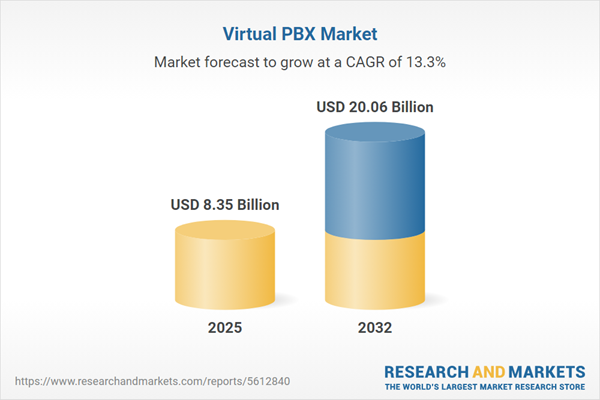Speak directly to the analyst to clarify any post sales queries you may have.
The virtual PBX market is rapidly evolving as organizations accelerate the adoption of cloud-based communication to meet new operational demands. This trend, driven by shifting work models and the need for flexible, scalable technology, is transforming business communications globally.
Market Snapshot: Virtual PBX Market Growth and Opportunities
The Virtual PBX Market grew from USD 7.40 billion in 2024 to USD 8.35 billion in 2025. It is expected to continue growing at a CAGR of 13.25%, reaching USD 20.06 billion by 2032. Organizations are accelerating digital transformation, seeking enhanced collaboration, and prioritizing secure, cost-efficient telephony. These drivers expand the market for unified business communications, supporting both large enterprises and smaller businesses as they transition to modern voice, messaging, and integrated data services.
Scope & Segmentation
This research delivers comprehensive coverage across solution types, verticals, and deployment environments. Key segmentation includes:
- Service Type: Data services, messaging services (chat and SMS), voice services (call forwarding and VoIP)
- Pricing Model: Pay-as-you-go options, subscription-based offerings
- Business Size: Large enterprises, mid-sized enterprises, small businesses
- Industry Vertical: Finance (banking institutions, investment firms), healthcare (hospitals, private practices), retail (brick-and-mortar, e-commerce)
- Deployment Mode: Cloud-based, on-premises
- End-User Requirements: Customizable features (CRM and system integrations), scalability for user expansion
- Technology: Analog systems, digital systems
Regional perspectives include the Americas (United States, Canada, Latin America), Europe, Middle East & Africa (including leading and emerging markets), and Asia-Pacific (such as China, India, Japan, Australia, Southeast Asian markets).
The competitive landscape highlights a mix of established telecom leaders and agile, cloud-native entrants, with players like Cisco Systems, Microsoft, Mitel, 8x8 Inc., RingCentral, Zoom Video Communications, and regional specialists responding to unique market needs.
Key Takeaways for Senior Decision-Makers
- Virtual PBX adoption is propelled by flexible remote and hybrid work environments, enabling organizations to support distributed teams while maintaining robust connectivity.
- Artificial intelligence and machine learning are enriching PBX platforms, optimizing call routing, monitoring quality, and generating actionable analytics for business process improvement.
- Security requirements are growing in complexity. Providers are embedding encryption and threat detection tools across infrastructure to meet compliance and safeguard enterprise data.
- The seamless integration of unified communications—including voice, conferencing, and messaging—into virtual PBX is creating single-vendor solutions that streamline management and lower overall costs.
- Industry-specific solutions, customizable integrations, and modular pricing are fostering faster deployment and ROI across sectors such as finance, healthcare, and retail.
Tariff Impact: Navigating Trade Disruptions in Virtual PBX Supply Chains
In 2025, adjustments in United States tariffs are increasing costs for physical PBX hardware imported from global suppliers. Vendors are recalibrating sourcing strategies, such as adopting local manufacturing partnerships and diversifying vendor relationships. This has prompted many to strengthen inventory management and increase reliance on software-centric virtual PBX and softphone deployments, which offer greater resilience in the face of trade-related cost fluctuations.
Methodology & Data Sources
This report applies a rigorous mix of secondary and primary research, drawing from industry publications, regulatory filings, and technology white papers alongside executive interviews and user feedback. Data triangulation, normalization, and expert validation ensure comprehensive and reliable insights into market dynamics, competitive intensity, and segment performance.
Why This Report Matters
- Enables leaders to respond proactively to shifting communication technologies and complex trade influences in global PBX supply chains.
- Guides investment by mapping out segment-specific growth opportunities and actionable strategies for operational optimization.
- Equips decision-makers with comparative intelligence on competitors and innovations, supporting confident technology selection and deployment navigation.
Conclusion
Virtual PBX solutions are central to enterprise agility and connectivity as communications ecosystems undergo transformation. This report offers a structured roadmap for assessing strategic opportunities, optimizing deployments, and future-proofing investments in a dynamic market.
Additional Product Information:
- Purchase of this report includes 1 year online access with quarterly updates.
- This report can be updated on request. Please contact our Customer Experience team using the Ask a Question widget on our website.
Table of Contents
3. Executive Summary
4. Market Overview
7. Cumulative Impact of Artificial Intelligence 2025
Companies Mentioned
The companies profiled in this Virtual PBX market report include:- 3CX
- 8x8 Inc.
- AstraQom Prime LLC
- AT&T Intellectual Property
- Atlantech Online, Inc.
- Barracuda Networks, Inc.
- BullsEye Telecom by Lingo Management
- Callhippo
- Cisco Systems, Inc.
- D-Link Corporation
- DIALPAD, INC.
- DigitalWell
- Digitcom Telecommunications Inc.
- Freshworks Inc.
- FusionPBX
- Grasshopper by GoTo
- IFN.com Inc. d/b/a TollFreeForwarding.com
- Microsoft Corporation
- Mitel Networks Corporation
- Nextiva, Inc.
- Panasonic Corporation
- PortaOne, Inc.
- RingCentral, Inc.
- THE REAL PBX LIMITED
- TPX Communications
- UniTel Voice, LLC
- Verizon by XO Communication
- VirtualPBX.Com, Inc.
- Vonage America, LLC
- Xiamen Yeastar Information Technology Co., Ltd.
- Zoom Video Communications, Inc.
Table Information
| Report Attribute | Details |
|---|---|
| No. of Pages | 184 |
| Published | November 2025 |
| Forecast Period | 2025 - 2032 |
| Estimated Market Value ( USD | $ 8.35 Billion |
| Forecasted Market Value ( USD | $ 20.06 Billion |
| Compound Annual Growth Rate | 13.2% |
| Regions Covered | Global |
| No. of Companies Mentioned | 32 |









